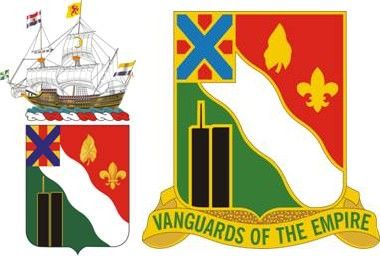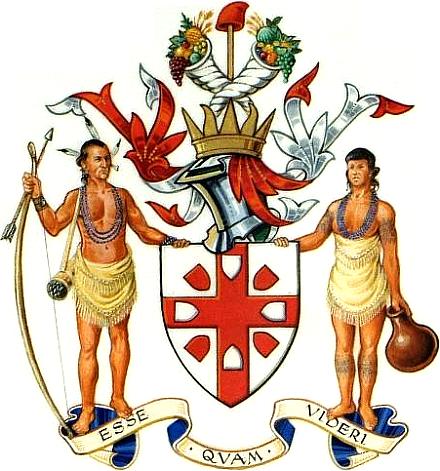
About Andrew Cusack
 Writer, web designer, etc.; born in New York; educated in Argentina, Scotland, and South Africa; now based in London.
Writer, web designer, etc.; born in New York; educated in Argentina, Scotland, and South Africa; now based in London. read more
News
Blogs
Reviews & Periodicals
Arts & Design
World
France
Mitteleuropa
Knickerbockers
Argentina
The Levant
Africa
Cape of Good Hope
Netherlands
Scandinavia
Québec
India
Muscovy
Germany
Academica
Recent American Heraldry

The Army Institute of Heraldry on 7 April 2006 approved a new coat-of-arms (left) and Distinctive Unit Insignia (right) for the 104th Military Police Battalion. According to the information provided by TIOH (as the Institute goes by), the red in the shield represents the unit’s role as a Field Artillery Battalion during World War II, while the green signifies the military police. The taro leaf represents the unit’s service in Hawai’i during the Spanish-American War, while the fleur-de-lis stands for service in France during both World Wars.
The black silhouette of the World Trade Center, a unique heraldic innovation, honors members of the unit who died in the Twin Towers on September 11, as well as the members of the battalion deployed to Manhattan. The service of earlier component units are represented in the canton. The red cross of St George symbolizes the War of Independence, while the blue saltire of St Andrew (akin to that of the Confederate battle flag) symbolizes the Civil War.
In blazonry, the language of heraldry, the shield is “per bend Gules and Vert, a bend wavy Argent, to chief a taro leaf and fleur-de-lis in bend Or; issuing from base the silhouette of the Twin Towers Sable edged of the fourth; on a canton of the last a cross Gules surmounted by a saltire Azure”. The crest is that which is standard to all New York Army National Guard units, depicting the Halve Maen on which Hudson explored New York harbor and his eponymous river. It is blazoned “from a wreath Argent and Gules, the full rigged ship “Half Moon” all Proper”.

Meanwhile, the President of the Senate of North Carolina petitioned the College of Arms in London for a coat of arms for the upper house of the state legislature. The devisal by Letters Patent of Arms, Crest, and Supporters was made 25 November 2005 by Garter, Clarenceux, and Norroy and Ulster Kings of Arms. The eight little shields (known as escutcheons in blazonry) on the main shield allude to the eight proprietary Lords of the Province of Carolina. The colonial grant for Carolina was one of the most feudal, allowing the Lords of Carolina to grant minor hereditary titles of nobility, and in terms of heraldry allowed for the appointment of a Carolina Herald to grant arms independently of the College of Arms in England. The noble coronet atop the shield is apparently one of the heraldic ornaments worked out in 1705 for landgraves and cassiques in the Province of Carolina.
The shield of the coat of arms of the Senate of North Carolina is blazoned as “Argent on a Cross between four Escutcheons bases inwards Gules four Escutcheons bases also inwards Argent” while the crest is “Issuant from a Coronet of a Noble of the former Province of Carolina Or a Cap of Liberty Gules raised upon a Pole Or between two Cornucopiae in saltire Argent replenished proper”. The supporters are “On each side an Aborigine of North Carolina as depicted by John White in the reign of Queen Elizabeth the First that on the dexter a Warrior supporting with his exterior hand a Long Bow and holding an Arrow girded at his back a Quiver that on the sinister a Woman holding in her exterior hand a Gourd all proper”.
An interesting note: the lower house of North Carolina’s General Assembly was known as the House of Commons until the conquest of the South during the Civil War.
Images from the United States Army Institute of Heraldry and the College of Arms respectively.
Search
Instagram: @andcusack
Click here for my Instagram photos.Most Recent Posts
- Faithful Shepherd of the Falklands April 8, 2025
- Articles of Note: 8 April 2025 April 8, 2025
- Proportionality Destroys Representation April 8, 2025
- Sag Harbor Cinema March 26, 2025
- Teutonic Takeover March 10, 2025
Most Recent Comments
Book Wishlist
Monthly Archives
Categories



I think that the arms of the North Carolina Senate are very fine from every point of view, but the the stuff from the Army Institute of Heraldry is too busy, badly proportioned and just plain ugly.
Must agree with R T that NYARNG DUI is rather busy,
perhaps that might be since Unit is in New York. Not reallya “Traditional” rendering but then it is a “New” Unit.
Having worn the Regimental insignia of 5 units so far in my career, (and soon to be a sixth), I’m always fascinated to learn the history and symbolism behind the heraldry. Most units in fact make learning the unit history, including the parts of the Regimental Crest a rite of passage for soldiers new to the unit.
Blazoning the World Trade Center towers as the “Twin Towers” is problematic as it does not state in the blazon which “Twin Towers” they are. Those familiar with the history of the unit may know, but the blazon should be able to be interpreted by artists generally and you wouldn’t want the Petronas Towers appearing in these arms, for instance.